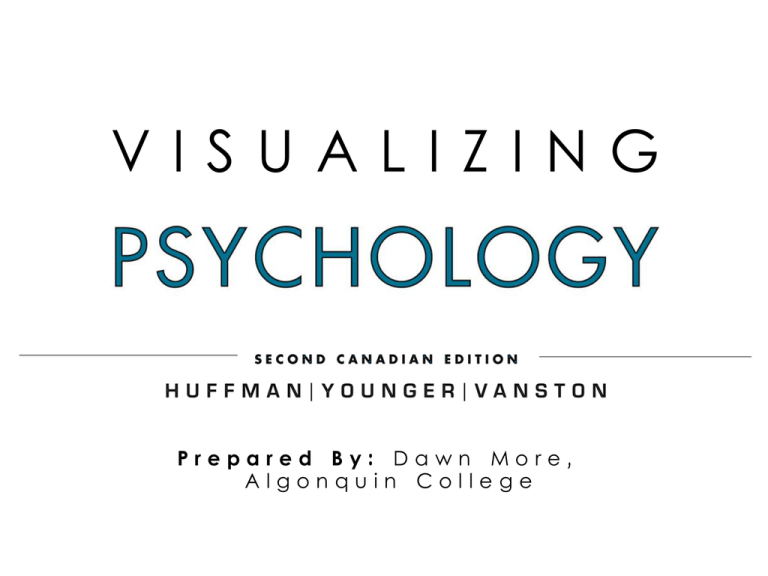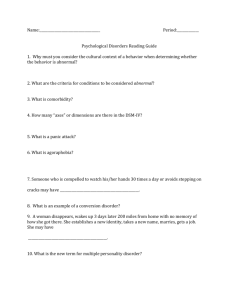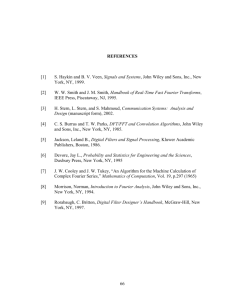
VISUALIZING
Prepared By: Dawn More,
Algonquin College
Chapter 13:
Psychological
Disorders
Media Enhanced PowerPoint Presentation
Copyright © 2013 John Wiley & Sons, Canada Ltd
2
Lecture Overview
•
•
•
•
•
•
Studying Psychological Disorders
Anxiety Disorders
Mood Disorders
Schizophrenia
Other Disorders
How Gender and Culture Affect Abnormal
Behaviour
Copyright © 2013 John Wiley & Sons, Canada Ltd
3
S t u d y i n g
P s y c h o l o g i c a l
D i s o r d e r s
LEARNING OBJECTIVES:
1. Describe the four criteria for
identifying abnormal behaviour.
2. Review how views of abnormal
behaviour have changed through
history.
3. Explain how the DSM-IV-TR is used
to classify psychological disorders.
Copyright © 2013 John Wiley & Sons, Canada Ltd
4
Studying Psychological
Disorders
• Abnormal behaviour: patterns of emotion,
thought, and action considered
pathological for one or more of four
reasons:
– statistical infrequency
– disability or dysfunction
– personal distress
– violation of norms
Copyright © 2013 John Wiley & Sons, Canada Ltd
5
S t u d
P s y c h o
D i s o r
F o u r
C
f o r
A b
B e h a
y i n g
l o g i c a l
d e r s :
r i t e r i a
n o r m a l
v i o u r
Copyright © 2013 John Wiley & Sons, Canada Ltd
6
Studying Psychological
Disorders
• Historical perspectives:
– In ancient times, people believed demons were
the cause of abnormal behaviour.
– In the 1790s, Pinel and others began to
emphasize disease and physical illness, which
later developed into the medical model.
Copyright © 2013 John Wiley & Sons, Canada Ltd
7
Studying Psychological
Disorders
• Modern
psychology
includes
seven major
perspectives
on abnormal
behaviour.
Copyright © 2013 John Wiley & Sons,
Canada Ltd
8
Studying Psychological
Disorders: Classifying
Abnormal Behaviour
• The Diagnostic and Statistical Manual of
Mental Disorders (DSM-IV-TR):
– provides detailed descriptions of symptoms
– contains over 200 diagnostic categories
grouped into 17 major categories and five
dimensions (or axes)
Copyright © 2013 John Wiley & Sons, Canada Ltd
9
Studying Psychological
Disorders: Classifying
Abnormal Behaviour
• Five Axes of DSM-IV-TR (guidelines for
making decisions about symptoms)
– Axis I (current clinical disorders)
– Axis II (personality disorders and mental
retardation)
– Axis III (general medical information)
– Axis IV (psychosocial and environmental
problems)
– Axis V (global assessment of functioning)
Copyright © 2013 John Wiley & Sons, Canada Ltd
10
Copyright © 2013 John Wiley & Sons, Canada Ltd
11
Pause and Reflect:
Check & Review
1. What are the four major standards for
identifying abnormal behaviour?
2. The _____ provides detailed descriptions
of the key symptoms of abnormal
behaviour.
Copyright © 2013 John Wiley & Sons, Canada Ltd
12
A n x i e t y
D i s o r d e r s
LEARNING OBJECTIVES:
1. Describe the symptoms of
generalized anxiety disorder, panic
disorder, phobias, and obsessivecompulsive disorder.
2. Summarize how psychological,
biological, and sociocultural
factors contribute to anxiety
disorders.
Copyright © 2013 John Wiley & Sons, Canada Ltd
13
Anxiety Disorders
• Anxiety Disorder: characterized by
unrealistic, irrational fear; four major
anxiety disorders
1. Generalized Anxiety Disorder: persistent,
uncontrollable, and free-floating anxiety
2. Panic Disorder: sudden and inexplicable
panic attacks
Copyright © 2013 John Wiley & Sons, Canada Ltd
14
Anxiety Disorders
3. Phobia: intense,
irrational fear of a
specific object or
situation
4. Obsessive-Compulsive
Disorder (OCD):
intrusive, repetitive
fearful thoughts
(obsessions), urges to
perform repetitive,
ritualistic behaviours
(compulsions), or both
Copyright © 2013 John Wiley & Sons, Canada Ltd
15
Anxiety Disorders
• Explanations of Anxiety Disorders:
– Psychological—faulty cognitions, maladaptive
learning
– Biological—evolution, genetics, brain
functioning, biochemistry
– Sociocultural—environmental stressors,
cultural socialization
Copyright © 2013 John Wiley & Sons, Canada Ltd
16
M o o d
D i s o r d e r s
LEARNING OBJECTIVES:
1. Explain how major depressive
disorder and bipolar disorder
differ.
2. Summarize the research on the
biological and psychological
factors that contribute to mood
disorders.
Copyright © 2013 John Wiley & Sons, Canada Ltd
17
Mood Disorders
• Mood Disorders: characterized by extreme
disturbances in emotional states
• Two Main Types of Mood Disorders:
– Major Depressive Disorder: long-lasting
depressed mood that interferes with the ability
to function, feel pleasure, or maintain interest
in life
– Bipolar Disorder: repeated episodes of mania
and depression
Copyright © 2013 John Wiley & Sons, Canada Ltd
18
Mood Disorders
• Using this hypothetical graph, note how major
depressive disorders differ from bipolar
disorders.
Copyright © 2013 John Wiley & Sons, Canada Ltd
19
Mood Disorders
• Explanations of Mood Disorders:
– Biological—brain functioning, neurotransmitter
imbalances, genetics, evolution
– Psychosocial—environmental stressors,
disturbed interpersonal relationships, faulty
thinking, poor self-concept, learned
helplessness, faulty attributions
Copyright © 2013 John Wiley & Sons, Canada Ltd
20
Pause and Reflect:
Check & Review
1. What are the four major anxiety
disorders?
2. _____ are characterized by repeated
episodes of mania and depression.
Copyright © 2013 John Wiley & Sons, Canada Ltd
21
S c h i z o p h r e n i a
LEARNING OBJECTIVES:
1. Describe some common symptoms of
schizophrenia.
2. Compare the traditional (four-group)
system for classifying different types of
schizophrenia with the (two-group)
system that has recently emerged.
3. Summarize the biological and
psychosocial factors that contribute to
schizophrenia.
Copyright © 2013 John Wiley & Sons, Canada Ltd
22
Schizophrenia
• Schizophrenia: group of psychotic disorders,
characterized by a general loss of contact with
reality
• Five areas of major disturbance:
1.
2.
3.
4.
5.
Perception (hallucinations)
Language (word salad, neologisms)
Thoughts (psychosis, delusions)
Emotion (exaggerated or flat affect)
Behaviour [unusual actions (e.g., catalepsy, waxy
flexibility)]
Copyright © 2013 John Wiley & Sons, Canada Ltd
23
Schizophrenia
Copyright © 2013 John Wiley & Sons, Canada Ltd
24
G e n e t i c s a n d
S c h i z o p h r e n i a
Copyright © 2013 John Wiley & Sons, Canada Ltd
25
Schizophrenia
• Explanations of
Schizophrenia:
– Biological—genetic
predisposition,
disruptions in
neurotransmitters, brain
abnormalities
– Psychosocial—stress,
disturbed family
communication
Copyright © 2013 John Wiley & Sons, Canada Ltd
26
Schizophrenia – The
Biopsychosocial Model
Copyright © 2013 John Wiley & Sons, Canada Ltd
27
Pause and Reflect:
Check & Review
1. _____ is a group of psychotic disorders,
characterized by a general loss of contact
with reality.
2. What are the three biological and two
psychological factors that may contribute
to schizophrenia?
Copyright © 2013 John Wiley & Sons, Canada Ltd
28
O t h e r
D i s o r d e r s
LEARNING OBJECTIVES:
1. Explain how substance abuse and
substance dependence differ.
2. Describe the types of dissociative
disorders.
3. Identify the major characteristics
of personality disorders.
Copyright © 2013 John Wiley & Sons, Canada Ltd
29
Other Disorders
• Substance-related disorder abuse of, or
dependence on, a mood- or behaviouraltering drug)
• Two general groups:
– Substance abuse (interferes with social or
occupational functioning)
– Substance dependence (shows physical
reactions, such as tolerance and withdrawal)
Copyright © 2013 John Wiley & Sons, Canada Ltd
30
Other Disorders:
Substance-Related
Disorder
Copyright © 2013 John Wiley & Sons, Canada Ltd
31
Other Disorders:
Substance-Related
Disorder
• People with substance-related disorders
also commonly suffer from other
psychological disorders, a condition known
as comorbidity.
Copyright © 2013 John Wiley & Sons, Canada Ltd
32
Other Disorders
• Dissociative Disorders: splitting apart (disassociation) of experience from memory or
consciousness
• Types of Dissociative Disorders:
– Dissociative Amnesia
– Dissociative Fugue
– Dissociative Identity Disorder (DID)
Copyright © 2013 John Wiley & Sons, Canada Ltd
33
Other Disorders
• Best known and most severe dissociative
disorder:
– Dissociative Identity Disorder (DID): presence
of two or more distinct personality systems in
the same person at different times (previously
known as multiple personality disorder)
Copyright © 2013 John Wiley & Sons, Canada Ltd
34
Other Disorders
• Personality Disorder: inflexible, maladaptive
personality traits causing significant impairment of
social and occupational functioning
• Examples of personality disorders:
– Antisocial Personality Disorder
– Borderline Personality Disorder
Copyright © 2013 John Wiley & Sons, Canada Ltd
35
Other Disorders
• Antisocial Personality Disorder: profound
disregard for, and violation of, the rights of
others
• Key Traits:
– Egocentrism
– Lack of conscience
– Impulsive behaviour
– Superficial charm
Copyright © 2013 John Wiley & Sons, Canada Ltd
36
Other Disorders
• Explanations of Antisocial Personality
Disorder
– Biological—genetic predisposition, abnormal
brain functioning
– Psychological—abusive parenting,
inappropriate modelling
Copyright © 2013 John Wiley & Sons, Canada Ltd
37
Other Disorders
• Borderline Personality Disorder (BPD):
impulsivity and instability in mood,
relationships, and self-image
• Explanations of BPD:
– Psychological—childhood history of neglect,
emotional deprivation, abuse
– Biological—genetic inheritance, impaired brain
functioning
Copyright © 2013 John Wiley & Sons, Canada Ltd
38
Pause and Reflect:
Check & Review
1. People with substance-related disorders
also commonly suffer from other
psychological disorders, a condition
known as ______.
2. A serial killer would likely be diagnosed as
a(n) _____ disorder.
Copyright © 2013 John Wiley & Sons, Canada Ltd
39
H o w
G e n d e r
a n d
C u l t u r e
A f f e c t
A b n o r m a l
B e h a v i o u r
LEARNING OBJECTIVES:
1.
2.
3.
Identify the biological, psychological, and
social factors that might explain gender
differences in depression.
Explain why it is difficult to directly compare
mental disorders across cultures.
Explain why recognizing the difference
between culture-general and culture-bound
disorders and symptoms can help prevent
ethnocentrism in the diagnosis and treatment
of psychological disorders.
Copyright © 2013 John Wiley & Sons, Canada Ltd
40
How Gender and Culture
Affect Abnormal
Behaviour
• Gender and Depression:
– Women are more often depressed. Why?
Combination of biological, psychological, and
social forces (biopsychosocial model)
Copyright © 2013 John Wiley & Sons, Canada Ltd
41
How Gender and Culture
Affect Abnormal
Behaviour
• Culture-General Symptoms: shared
symptoms across cultures
Copyright © 2013 John Wiley & Sons, Canada Ltd
42
How Gender and Culture
Affect Abnormal
Behaviour
• Culture-Bound Symptoms: unique
symptoms that differ across cultures
Copyright © 2013 John Wiley & Sons, Canada Ltd
43
How Gender and Culture
Affect Abnormal
Behaviour
• Gender and Cultural Diversity: Numerous
culturally general symptoms, but significant
differences exist in:
– Prevalence
– Form
– Onset
– Prognosis
Copyright © 2013 John Wiley & Sons, Canada Ltd
44
Pause and Reflect:
Check & Review
1. What factors contribute to the higher
incidence of depression among women
than men?
2. ____________ are shared symptoms
across cultures
Copyright © 2013 John Wiley & Sons, Canada Ltd
45
Multimedia
Web Links
Understanding Mental Illness
Mental illnesses can take many forms, just as
physical illnesses do.
Treatments
A history of treatments for the insane and instable.
Diagnostic and Statistical Manual of Mental
Disorders, Fourth Edition (DSM-IV)
Psychiatric Diagnoses are categorized by the
Diagnostic and Statistical Manual of Mental
Disorders, 4th. Edition.
The Facts on Anxiety Disorders
Everyone experiences anxiety from time to time as a
result of a situation that we perceive as threatening,
such as having to do an oral presentation, having a
near-miss with a car, or waiting for the results of a
lab test.
What is Generalized Anxiety Disorder?
Generalized Anxiety Disorder, or GAD, is an anxiety
disorder that affects about 5% of the population.
Make Better Health Decisions
Healthwise® Knowledgebase
Panic Disorder
This site will help you understand the Panic Trick and
show you how to recover from Panic Disorder.
The Facts on Phobias
Phobias are fears sparked by certain situations that
can interfere with a person's coping abilities or lead
them to stay away altogether.
Treating real trauma and phobias in a virtual world
You’re deathly afraid of flying, but are buckled into
your seat watching the scenery disappear outside
the window.
Obsessive-Compulsive Disorder
What is OCD?
What is Obsessive Compulsive Disorder?
Obsessive Compulsive Disorder is a common,
treatable anxiety disorder.
Copyright © 2013 John Wiley & Sons, Canada Ltd
46
Multimedia
Web Links
Obsessive Compulsive Disorder (OCD)
Obsessive Compulsive Disorder is an anxiety disorder
characterized by persistent intrusive ideas, thoughts,
impulses or images (obsessions) which often result in
performing compulsive rituals over and over again.
Resources
The Mood Disorders Society of Canada believes that
consumers, families and caregivers are entitled to
clear, accurate information about mood disorders
and other mental illnesses.
Depression vs. Bipolar Disorder
A caregiver's guide to how to properly identify the
problem—and the best ways to help
A Report on Mental Illness in Canada
Chapter 2 Mood Disorders
Hip-hop artist explores schizophrenia
The tune is haunting, the beat catchy, the topic
unusual—schizophrenia.
Schizophrenia
Epidemiology
Montreal centre a leader in brain imaging
Montreal is about to become home to one of the
world's most advanced brain research centres.
Schizophrenia
Aetiology
Schizophrenia and the Brain
The brain is one of the most vital organs of the
central nervous system along with the spinal cord.
Alcohol and Drugs
Rates of Substance Abuse across Canada
How Alcoholism Works
We've all seen the stereotypical "drunk" in movies
and television shows: He's the one staggering down
the street, clothing askew, slurring his words and
tripping over his own feet.
Copyright © 2013 John Wiley & Sons, Canada Ltd
47
Multimedia
Web Links
A Report on Mental Illness in Canada
Chapter 5 Personality Disorders
Borderline Personality Disorder
From the Inside Out
Robert Pickton Trial
Some facts about the case
Greyhound bus killer found not criminally
responsible
Vince Li has been found not criminally responsible
for the unprovoked killing and beheading of fellow
passenger Timothy McLean on a Greyhound bus last
summer.
Borderline Personality Disorder (BPD): Emotional
Dysregulation
Borderline Personality Disorder is a very specific and
serious mental illness which is characterized by
persistent instability in moods, interpersonal
relationships, self-image, and behavior.
Gender Differences in diagnosing depression
Gender issues in diagnosing depression arise due to
physician bias and patient reporting bias.
Culture Specific Diseases
There are some diseases that have very limited
distributions around the world due to the fact that
they are caused by unique combinations of
environmental circumstances and cultural practices.
Copyright © 2013 John Wiley & Sons, Canada Ltd
48
Multimedia
Videos
Imaging Antidepressant Accuracy (1:26)
A simple one-hour brain scan could predict who will
respond to an antidepressant and who will not.
Blues to Brains (1:38)
New research into depression is showing that
antidepressants are not only changing the chemicals
inside the brain, they actually make the brain grow
new cells.
Exercise and Depression: aka Ride the Blues Away
(1:26)
An estimated 19 million Americans experience
depression in any given year.
Buzzed Brain (1:23)
Of all the addictions, some scientists say addiction to
alcohol is one of the most powerful.
Maternal Separation (1:21)
There's no substitute for a mother's love.
Teen Brains on Alcohol (1:44)
A highly anticipated report from the National
Academy of Sciences on underage drinking is due out
soon, and groups on all sides of the issue are ready
to debate its contents.
Copyright © 2013 John Wiley & Sons, Canada Ltd
49
Multimedia
Animations
Schizophrenia
Can you tell which one of these people has
schizophrenia? Are there telltale signs that you can
pick out? Probably not. Schizophrenia, like many
mental illnesses, is often not outwardly visible. Yet it
affects many people; an estimated 1% of all people
develop schizophrenia in their lifetime.
Copyright © 2013 John Wiley & Sons, Canada Ltd
50
Copyright
Copyright © 2013 John Wiley & Sons Canada, Ltd.
All rights reserved. Reproduction or translation of this
work beyond that permitted by Access Copyright (The
Canadian Copyright Licensing Agency) is unlawful.
Requests for further information should be addressed
to the Permissions Department, John Wiley & Sons
Canada, Ltd. The purchaser may make back-up
copies for his or her own use only and not for
distribution or resale. The author and the publisher
assume no responsibility for errors, omissions, or
damages caused by the use of these programs or
from the use of the information contained herein.
Copyright © 2013 John Wiley & Sons, Canada Ltd
51




